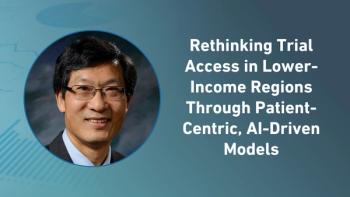
- Applied Clinical Trials-06-01-2002
Informed Consent
Kenneth Getz and Deborah Borfitz, CenterWatch (Boston, MA, 2002) 306 pp., $16.95.
Informed Consent
Kenneth Getz and Deborah Borfitz, CenterWatch (Boston, MA, 2002) 306 pp., $16.95.
When potential subjects start reading this book, investigators and study coordinators will hear questions theyve never been asked before. To be prepared for informed patients, every clinical research professional should read this Consumers Guide to the Risks and Benefits of Volunteering for Clinical Trials.
Research sites will surely gain a competitive advantage when recruiting subjects if they can satisfy these well-informed volunteers with clear answers to their questionsand subjects who have studied this book carefully will have a great many of them.
Chapter 3, Doing Your Homework, provides dozens of questions that potential subjects can ask as they, their families, and friends play the role of dogged detectives to determine whether particular trials are right for them.
Questions range from the scientific (what phase is the study?) to the professional (are check-in procedures private and confidential?) and from the medical (finding out everything possible about the disease or condition) to the logistical (how far away is the research site?).
Getz and Borfitz sugarcoat nothing as they describe and explain clinical trials. They set their tone early with a frank and clear description of the difference between experimental treatment and regular medical care:
It is a common misconception that receiving treatment in a clinical trial is the same as receiving treatment as a patient. The hard reality about a clinical trial is that it is designed to answer a scientific question, not to provide medical treatment. . . . When youre a research subject, you often feel like a patient. You usually make visits to a doctors office where youre examined by a doctor, undergo lab tests and receive a medication. In many ways participating in a clinical trial seems just like visiting with your doctor to receive medical care. But your doctors primary goal is to help you feel better. The principal investigators primary goal is to see how you will react to a new drug in order to determine whether that drug will be medically useful.
Readers who have studied chapters 2 and 3and have done their homework thoroughlymay even ask questions to which they are listening for specific answers, because near the end of chapter 2, the authors explain that
The research center isnt the onlyand may not even be the bestsource of information about a particular clinical trial. Research centers recommend specific clinical trials for a variety of reasonsscientific, political and even economic factors are all influences. Some clinical trials bestow professional prestige and monetary rewards, for example, on researchers and research centers. Often these rewards may cloud otherwise sound medical decisions.
Chapter 4, Giving Your Informed Consent, explains a typical consent form section-by-section, with an emphasis on subjects rights and responsibilities. It includes five comprehensive checklists of suggested questions about the trial, care and treatment, personal and privacy matters, costs and compensation, and the research staff. These are not frivolous questions, and not all sites will have good answers to such queries as Why did the investigator decide to get involved in clinical research? or What sort of research training and certification have the investigator and coordinator had?
Chapter 5 outlines the history of human subject protection and Chapter 6 describes the special considerations involved in trials with vulnerable populations. Chapter 8, Finding Clinical Trials, provides step-by-step strategies for locating appropriate trials and includes a rich and current array of government and industry sources with Web addresses.
The book as a whole presents a well-balanced view of the clinical research, but Chapter 7 is particularly noteworthy for its explanation of the professionals and procedures in place to ensure that your rights are protected and that the risk of participation is minimized. In that chapter, titled What to Do When Things Go Wrong, concise bullet lists outline the responsibilities of sponsors, investigators, IRBs, and coordinators. Those lists are followed by detailed information about the organizations and agencies that can help when a subject has a complaint.
The book is a mixture of concrete advice that a reader can put into action and clear (though sometimes a bit academic for a lay reader) explanations of the underlying history and philosophy underlying the current regulations and guidelines to protect human subjects.
One way to describe Informed Consent is as a three-bookmark book. I read it on trains and planes with boarding passes to mark not only the page I was reading but also two appendixes: the glossary and the history of regulations. Once back in my office, I marked each appendix with a permanent tab for easy reference to the Glossary of Terms, History of Regulations Affecting Patient Protection in Clinical Research, the Declaration of Helsinki, the Belmont Report, 45 CFR 46, 21 CFR 50, Form 1572, the Directory of Health Associations, and the Directory of Biotechnology and Pharmaceutical Companies.
This book has been installed in the Applied Clinical Trials editorial reference libraryand it belongs in every research center.
Patients who read this book and do their homework before consenting to participate in a clinical trial will give new depth and dimension to the concept of informed consent.
Jane Ganter is editor-in-chief ofApplied Clinical Trials.
Articles in this issue
over 23 years ago
Privacy Restrictions Alarm Clinical Researchersover 23 years ago
Clinical Research in Mexico: An Overviewover 23 years ago
Good Clinical Practice: 10 Steps for Improving FDA GCP Inspectionsover 23 years ago
Nobody Knows the Costs They?ve Seenover 23 years ago
Filling in the EU Gaps on Clinical Trials Rulesover 23 years ago
HIPAA Privacy Rule: Effect on Medical Researchover 23 years ago
Letters to the Editorover 23 years ago
Ethical Review and the Globalization of Clinical Trialsover 23 years ago
Measuring Investigator SatisfactionNewsletter
Stay current in clinical research with Applied Clinical Trials, providing expert insights, regulatory updates, and practical strategies for successful clinical trial design and execution.






.png)



.png)



.png)
.png)
